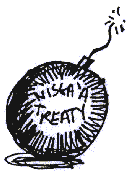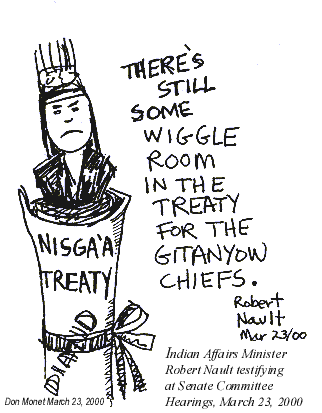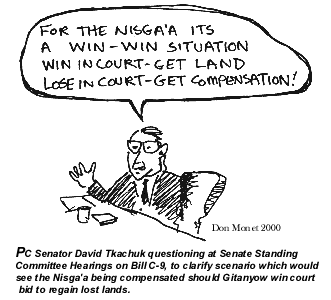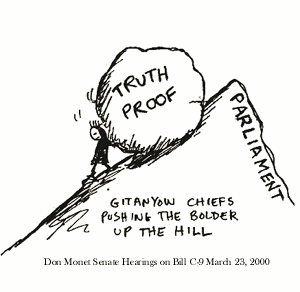"It Is An Act Of Agression" Gitksan Leader
Claims Nisga'a Treaty Illegal Grab Of Gitanyow Lands
Vancouver Sun, November 21, 1998.
 "Is
the Nisga'a Treaty Legal?"A former Gitksan chief says
federal and provincial officials ignored judicial dictates concerning
aboriginal title and negotiations.
"Is
the Nisga'a Treaty Legal?"A former Gitksan chief says
federal and provincial officials ignored judicial dictates concerning
aboriginal title and negotiations.
"Our story needs to be told. Our rights need to be
protected. Our chiefs still sing the songs and carve the crests on
totems which prove to us that we have always had an interest in lands
and resources which are about to be given to our Nisga'a neighbors"
Axwin Desw, House of Malii.

"Kitwancool holds a single registry over their entire
territory. This area is registered as the trapping and hunting grounds
of the Kitwancool. The Kitwancool people decided to form a union to hold
their grounds rather than register individually as was done elsewhere.
This was done in the 1920's. Originally the land was registered under
one simoghet (chief) - Gwasslam (Walter Douse) but later 2 simoghets
from each pdek (clan) became the governors over the entire Ansilenisxw
(territory) on behalf of all Kitwancool people. The advantage of this is
that the history of each house holds good as the basis for authority and
rights on the hunting and trapping grounds. Each house respects the
rights and laws of the other two houses. At the time of this
registration some non-indians were registering in Kitwancool territory.
The Kitwancool appealed to the game deptartment and the non-indians
withdrew. All Kitwancool descendants have the right to use their
respective lands and can do so by consulting with the capital
(Kitwancool) first. Kitwancool will respect its neighbors if the blanket
registered area inadvertently over-lapped the neighbor's land."
Late Gitanyow (Kitwancool) President Peter Williams on the origin and
evolution of the Kitwancool trapline: February, 1979.

"We did not thank you for coming before. We sent a
petition to Ottawa, we want our land back so we do not want a reserve,
we want our land back, it belongs to us. Mr. Vowell and Mr. Stewart
(Stewart-Vowell Commission on Gitksan Grievances - 1910) were here last
spring and wanted to give us a reserve but we would not have it. If a
reserve was given to us we know our hunting ground is not in it. We do
not want a reserve now. Do you think it is right that the white man
should buy land before our law suit is settled (our rights
defined)"
Biiyoosxw - August 1915.
When Myth and History Clash
William Rayner
All the drumbeats, ceremonies and rhetoric surrounding the Nisga'a treaty on its path to ratification have obscured the fact that a serious piece of historical revisionism is taking place.
Over the past several months the public and most of the media have swallowed assertions by native spokesman and their political supporters that the Nisga'a (then called the Naas River Band) were turned away at the legislature's doors in 1887 by the government of the day.
This scenario has been repeated so many times that it has taken on some sort of iconic certainty.
"We're back," Nisga'a Chief Joe Gosnell was quoted as saying last November. "This time we're going to be heard."
A few days later, Premier Glen Clark joined in with the observation that the legislature's doors were literally slammed in the Indians' faces. Gosnell, last August, varied the locale slightly, saying they "were sharply turned away... on the steps of the parliament buildings" after they had paddled 1,000 kilometres to Victoria.
We'll get to that 1,000-kilometre "paddle" in a moment. But first, the historic truth is that the delegation was never turned away. Rather, it met not once but twice with the government of Premier William Smithe.
On Thursday, Feb. 3, 1887, "at 11 o'clock in the forenoon, by appointment, a deputation of Indians from Fort Simpson and the Naas River was received by the Honourable, the Premier at his residence." Attending the meeting along with Smithe were cabinet members John Robson and A.E.B. Davie and bureaucrats from the Indian department. The Indian spokesmen were John Ryan, Richard Wilson, John Wesley and interpreter John Burton.
Five days later, the delegation (joined by two others) met with Robson and Davie again at the legislature.
The meeting at the premier's home was lengthy; the second one somewhat shorter. All the details are contained in a verbatim transcript that fills 21 pages of diminutive type in the Sessional Papers of the 1887 legislature-easily available to any historian, journalist, politician or Indian Chief.
The Indians didn't get anywhere with their requests, which appeared to centre on the need for a larger reserve. Because of reliance on an interpreter and the very different out look of the two races, the communication gap was almost unbridgeable. Nevertheless, sentiments and arguments were politely expressed and heard by both sides.
John Ryan: "I am actually astonished that I have entered into your house; and it puts me in mind that our Mother, Queen Victoria, allows me to come up to you and speak. You know how terrible the weather is now. At this very time we left our homes, our wives and our children on purpose to come and tell you how we are-poor and troubled. I know that you are wise, that you are in care of everything, and we came to explain thoroughly how we are fixed."
Smithe: "I simply want to say that we are glad to see you today; and we are always glad to hear what the Indians have to say. If they have any grievances with the government, the government is anxious to remove them, as far as it is possible for them to do so."
Richard Wilson: "You know, if they catch a little bird they put it in a cage. Probably that cage will be very fine; but still the bird will not be free. It will be in bondage; and that is the way with us, and is what we have come to tell you."
Smithe: "...I can say that, while I fully sympathize with your aspirations, you are laboring under a great delusion. Wilson has told us that you are slaves, and that you wished to be free. Now, you are not slaves; you are free, as much as white men are free, to do within the law, which, of course, governs us all."
John Wesley: "My fathers have sent me from Naas to speak before you...Our reserve is very little; and we have not got any timber land; neither have we got our hunting grounds. These are what we want and what we came for. We want you to cut out a bigger reserve for us, and what we want after that is a treaty."
Davie: "...Any reasonable request made with regard to the reserves...it is only necessary to mention to obtain. But if you go beyond that and speak about treaties, and think that his government, or the Dominion government, are going to say that all the land belongs to the Indians is it a very different thing."
What is clear is that the delegation was concerned that its reserve was too small to allow sustainable hunting, fishing and timber access. They were also under the mistaken impression that their land could be sold without their consent. (They read it in the papers, an Indian said.) This is apparently why Wesley and the rest wanted an enhanced reserve enshrined in a treaty.
Nor has anyone checked the weather and shipping news for early February 1887. To accept that some canoeists paddled 1,000 kilometres in the dead of winter is boggling enough; to realize that they would have arrived in the teeth of a blizzard is even more mind-bending.
The winter in southwestern B.C. was bad that week. Gales and snowstorms even kept some shipping confined to harbour. What did arrive in Victoria on Feb. 1, 1887, however, was the steam vessel Idaho from Alaska and the north coast. Both The Colonist and The Victoria Times reported that some Indians from the Naas River, who had traveled aboard the Idaho on their way to meet the premier, disembarked after the steamer docked.
The canoe journey down the B.C. coast and the slamming of the door in the Indians' faces may well be on the tradition of Nisga'a oral history.
But it is a rewriting of the record.
The delegation was never turned away. Rather, it met not once but twice with the government of Premier William Smithe.

IS THE NISGA'A TREATY LEGAL?
Neil Sterritt
It is not too late for federal Indian Affairs Minster Jane Stewart and provincial Aboriginal Affairs Minister Gordon Wilson to make the Nisga’a final agreement a fair modern day treaty. They can do what former ministers have failed to do: Withdraw the overlap lands and deal with them properly. Justice Paul Williamson, in his recent decision in Luuxhon v. The Queen in B.C. Supreme Court, set the legal basis for the ministers, He affirmed that the courts oblige Canada and British Columbia to negotiate in good faith with the Gitanyow.He also said this duty binds all representatives of the Crown. Crown representatives include Stewart and Wilson and the federal and provincial chief negotiators. The law on bad faith negotiations illustrates why good faith negotiations are required. It is a legal offence to defraud the public or any person of their land intentionally. In such cases, showing that the victim lost property is not necessary.
It is enough to show that the individual was at risk of losing property because of a fraud or deception. Gitanyow territories have important historical, cultural and economic value. The chiefs went to court in Luuxhon to protect their territories from encroachment by the Nisga’a treaty. In 1992, the Nisga’a leadership claimed 24,000 square kilometers of land in northernwestern B.C. The claim included the entire Nass valley (21, 150 square kilometres) Nisga’a leaders knew their 1992 claim included land owned not only by the Gitanyow, but the Gitksan and Tahltan peoples as well.
Gitksan and Gitanyow chiefs gave the Nisga’a Tribal Council a 300-page report - Tribal Boundaries in the Nass Watershed - in 1995. The report concluded the Nisga’a territory was about 7, 800 kilometers. Gitksan and Gitanyow chiefs expected Nisga’a leaders to respond to the report: They have refused to comment to this day.
The report was given to the provincial and federal ministers and their chief negotiators in 1995 and again in 1998 (when published by UBC Press). They to have declined comment. However, the provincial chief negotiator of the Gitanyow treaty table commissioned a similar study in 1995. It arrives at essentially the same conclusion. Imagining that the two provincial negotiators at the Gitanyow and Nisga’a treaty tables did not discuss these two reports is hard. Failure to do so is a lack of good faith toward the Gitanyow and Gitksan peoples. All three participants - Nisga’a, Canada, and British Columbia - are party to this deception. The Nisga’a breached aboriginal law by claiming land they do not own. However, it is the Crown in Canada and B.C. that has a legally enforceable fiduciary obligation to protect the interests of the Gitanyow (and Gitksan) people in the Nisga’a treaty negotiations.
As it stands, the Nisga’a treaty will enshrine extensive rights and benefits to 84 per cent of Gitanyow territory and private property and economic rights to key Gitanyow lands. The Gitanyow therefore went to court because Canada and B.C. persisted in developing a treaty that would create constitutionally protected Nisga’a’ rights over Gitanyow territory. In Luuxhon, Justice Williamson said the duty to negotiate in good faith must include the absence of any appearance of sharp dealing; disclosure of relevant factors; and negotiation “without oblique motive.
I will discuss these issues as they relate to the Gitanyow.
The appearance of any appearance of sharp dealing means that British Columbia and Canada must always act to fulfil their promises and obligations to First Nations. They must not employ legal or political sleight of hand in their dealings with First Nations. They must not ignore the evidence and hide behind so-called legal escape clauses. Under the Nisga’a treaty, the Crown will have fulfilled its obligation to the Nisga’a but tramples of on the rights of Gitanyow. It is not right that the first modern-day treaty in B.C. creates rights for one aboriginal group over the territory and objections of another. Canada and other governments have addressed similar overlap issues elsewhere. The Naskapi people of northern Quebec found themselves in this situis recommendation. The duty to disclose relevant factors calls on negotiators across Canada to try to resolve territorial overlaps with all affected parties. This was not done for the Nisga’a treaty.
The federal and provincial governments encourage tribal groups to resolve overlapping claims themselves. This is as it should be. However, this approach works only if both aboriginal parties intend to resolve the overlap “in good faith. What happens if a party claims land without reason or foundation, and Crown representatives know this to be so? Further, what happens if the party has no intention of resolving the overlap?
The Crown has taken the position, with the support of aboriginal people, to conclude treaties over undisputed lands, but not where there is an overlapping claim. However, what if Canada and B.C. want a treaty so badly that they are prepared to look the other way? By exaggerating their claim, the Nisga’a will get extensive rights and benefits outside their traditional territory. For example they will get fee simple lands economic benefits in key Gitanyow lands. The Nisga’a will also get fisheries management and a treaty right to hunt, along with Nisga’a heritage sites and place-naming in Gitanyow territory. Such rights and benefits are withheld from overlapping claims in the Yukon.
When they took their own aboriginal title claim to court (the Calder case, 1969-73), the Nisga’a only claimed their actual territory of about 7, 800 square kilometers. Thus Canada and B.C. have known since 1969 the actual size of the Nisga’a legal claim to territory. Yet Canada and B.C. have chosen to overlook this fact throughout the Nisga’a treaty negotiations.
As mentioned above, the Gitksan and Gitanyow provided an exhaustive analysis of aboriginal boundaries in the Nass Valley to B.C. and Canada in 1995. It found the Calder border of 1969 to be substantially correct. An internal provincial government report supports the findings of the Gitksan/Gitanyow report. Provincial ads on the Nisga’a treaty are deliberately misleading. They fail to mention these facts. Neither B.C. nor Canada has shown facts that contradict the findings of the reports on tribal boundaries, the Nisga’a self-imposed boundary in Calder nor the B.C government’s internal report. It can only be assumed that such evidence does not exist.
Have Canada and B.C. negotiated with the Gitanyow with oblique motive? I believe they have. Canada and B.C. have negotiated with the Gitanyow with the intention of vindicating and facilitating Nisga’a encroachment over Gitanyow territory. Also, since the 1997 judgement in Delgamuukw, both Canada and B.C. are aware of the high standards set by the Supreme Court of Canada. The court said those negotiations should also include other aboriginal nations which have a stake in the territory claimed. This aspect of Delgamuukw requires that the Gitanyow be part of Nisga’a negotiations , at least with respect to Gitanyow territory and resources. It was not in the federal or provincial government’s interest to do this. Canada and B.C. have ignored the Delgamuukw ruling in concluding the Nisga’a final agreement. Their efforts to push through the Nisga’a treaty may be motivated in part to bypass this obligation. This is another oblique motive for accelerated Nisga’a negotiations at the expense of Gitanyow rights. The Honour of the Crown. Gitanyow hereditary chiefs argue the Nisga’a people are not entitled to entrenched treaty rights or benefits in Gitanyow territory without Gitanyow consent.
If Canada and British Columbia feel compelled to sign a treaty now, they should, but only on lands to which the Nisga’a hold aboriginal title. The Nisga’a description in Calder defines their title area. Courts direct that the Crown must not conspire with a First Nation ready to take advantage of political or strategic opportunity to get treaty rights over a neighbor’s territory (Delgamuukw and Luuxhon). The Crown must remove all overlap lands from the Nisga’a treaty. Canada and British Columbia have a legal, ethical and moral obligation to suspend all rights and benefits ceded to the Nisga’a in Gitanyow, Gitksan and Tahltan territory.
It is the right thing for minister Wilson and Stewart to do. It is consistent with the direction from the courts. The honour of the Crown is at stake.
Neil Sterritt was the leader of the Gitksan - Wet’Suwet’en peoples from 1981 - 1987 and led them in the precedent setting Delgamuukw case that was eventually decided by the Supreme Court of Canada in December 1997. He was a treaty negotiator for the Gitksan and co-author of the book, Tribal Boundaries in the Nass Watershed. Mr. Sterritt has been involved in the land claims issue since 1973.
E-mail comments to: gitanyowchiefs@kermode.net